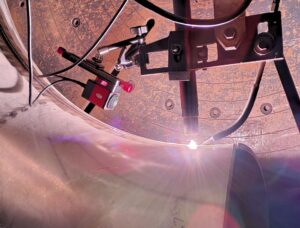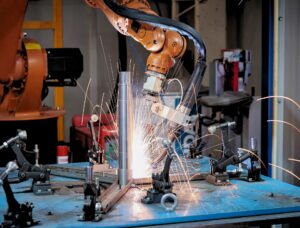The welding industry is evolving, and with it comes the demand for smarter, safer, and more precise ways to ensure weld quality. Traditional inspection methods and operator instincts are no longer enough—especially in industries where every millimeter matters. That’s why more welders are turning to welding cameras as part of their daily workflow. From improved weld inspection and real-time arc welding images to increased operator safety, welding cameras offer major advantages that help both manual and robotic welding teams succeed. Discover the top 5 reasons welders are starting to use welding cameras.
1. Real-Time Visibility = Real-Time Adjustments
With a weld monitoring camera, welders can see exactly what’s happening during the weld—whether they’re working with MIG welding, TIG welding (Tungsten Inert Gas), or plasma arc welding. This immediate feedback lets them spot and fix issues like porosity, incorrect angles, or arc instability on the spot.
Benefits:
- Minimize weld defects as they occur
- Improve arc control with visual cues
- Save time by reducing the need for rework
2. Better Welding Quality and Process Control
Welders want to produce consistent, high-quality results—and welding cameras help make that possible. With tools to monitor heat input, travel speed, and torch position, camera systems give welders better control over the process.
SEO Keywords Integrated:
- Optimize bead formation in metal arc welding
- Maintain precise angles in the MIG and MAG welding process
- Ensure clean, uniform results in laser welding and robotic welding
3. Improved Operator Safety
Safety is a top priority for any welder, especially when working in high-heat or hazardous environments. Cameras for welding allow remote monitoring, keeping welders out of harm’s way and reducing exposure to harmful light, heat, and fumes.
Safety Gains:
- Observe dangerous welds from a control room
- Eliminate the need for manual inspection in tight or elevated spaces
- Reduce fatigue from extended helmet time or poor posture
4. Fewer Downtimes and Faster Troubleshooting
Downtime hurts productivity—and welding cameras help prevent it. When something goes wrong, a quick review of the footage can help diagnose the problem faster than traditional inspection methods. This means quicker fixes and less wasted time.
Common Use Cases:
- Analyze video logs to troubleshoot machine errors
- Spot weld slag inclusion or gas flow issues
- Keep production lines running with fewer interruptions
5. Seamless Integration with Modern Welding Technology
As the industry embraces automation, welding cameras are becoming essential for maintaining precision and speed. From welding equipment with smart sensors to weld monitoring systems for automated lines, cameras integrate smoothly with today’s tech.
Modern Welding Applications:
- Support closed-loop automation in robotic welding
- Enable precision alignment for high-tolerance jobs
- Collect data for AI-based welding inspection techniques
Bonus: Visual Proof for Quality Control
More welders are also using welding visual inspection tools to document their work. Recorded arc welding images provide valuable proof of quality—whether for client assurance, audits, or compliance.
Conclusion: Top 5 Reasons Welders Are Starting to Use Welding Cameras
The days of welding by feel alone are fading fast. Today’s welders are embracing camera-based technology not just to improve their work—but to make it safer, faster, and more consistent.
If you’re looking to level up your welding operations, a welding camera from a trusted welding camera manufacturer is a solid investment. Whether you’re in heavy fabrication, aerospace, shipbuilding, or oil & gas, a weld monitoring camera gives you the edge you need to stay competitive.
Explore Mecaweld’s welding camera solutions—built for performance, safety, and next-level welding quality. Contact us now for more.



